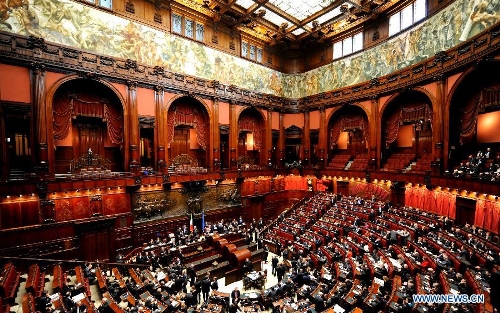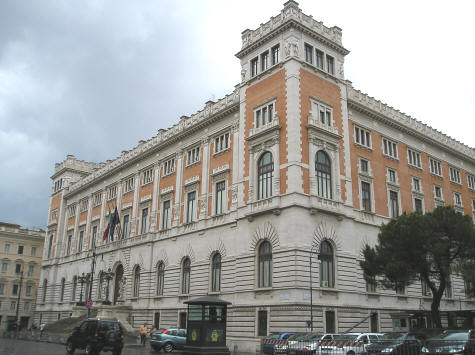Chamber of Deputies (Italy)
The Chamber of Deputies (Italian: Camera dei deputati, often only referred Camera) is in the Italian political system, the larger of the two chambers of Parliament.
The Italian Constitution defines the number of members of the Chamber of Deputies, which are referred to as Members of Parliament ( deputati ) and the title onorevole (abbreviation on. Approximately, honorable ') lead to 630 proof. The office of deputies is awarded contrary to the senator only by choice and for a period of five years - except in the case of an early dissolution of parliament.
Since 1871 the seat of the Chamber of Deputies of the Palazzo Montecitorio, where she has been meeting for the transfer of the capital of the former Kingdom of Italy to Rome. Previously, the Chamber of Deputies met in the Palazzo Carignano in Turin (1860-1865) and in the Palazzo Vecchio in Florence ( 1865-1871 ). From 1939 to 1943, the official name of the Chamber of Deputies ' Chamber of associations and guilds "was ( Camera dei Fasci e delle Corporazioni ).
The Italian parliament ( Chamber of Deputies and Senate ) can also meet jointly.
Election to the Chamber of Deputies
The Chamber of Deputies is elected by universal and direct suffrage; all eligible voters above 25 years may be elected deputies. Initially, the constitution provided for a variable number of Members based on the population of each constituency. The number of deputies but was finally set at 630. The first electoral law the election of the Constituent Assembly of 1946 provided for a pure proportional representation for the election of the Italian Parliament. For the Chamber of Deputies this happened on a national basis for calculation.
In 1994, a new electoral law for the Chamber of Deputies was adopted. With the entry into force of this Act began the era of the so-called Second Republic, which consisted in the abolition of the pure proportional representation for Italy. 75 % of the seats (ie 475 ) were elected by majority vote. In each of the 475 electoral districts into which the Italian territory was divided, was chosen from several candidates from those who could unite the most votes. This system formed the basis of bipolarity ( bipolarismo ) is: usually vary a candidate of the center-right Alliance and the center- left coalition presented in each constituency in addition to the candidates of the smaller parties. The remaining 25 % of the seats (ie 155) were determined by the system of proportional representation, to compensate for possible inequalities that may arise by a majority vote. The Italian territory is divided into 27 electoral districts for this purpose (actually a constituency per region, the most populous regions, however, were divided into a number of constituencies ) where now the lists of each party ( no electoral alliances ) have been established.
After only three legislative periods proportional representation was introduced in 2005 for the election of the Chamber of Deputies again. However, the electoral alliance with a relative majority receives a majority premium ( additional number of deputies, "reinforced proportional representation "). The Italian territory is divided for this purpose into electoral districts which correspond roughly with the regions (12 polling stations ( electoral district abroad) were assigned to Italians living abroad ). The allocation of seats in the Chamber of Deputies done on a national basis according to the number of votes received by each list. To get the majority premium, multiple lists can coalesce one another: that list alliance, which has received the majority of votes shall be allocated 340 seats in the Chamber of Deputies if it already had not so entitled to more seats.
Access to the Chamber of Deputies is - as for example in Germany by the five-percent hurdle - limited by restrictive clauses. To list covenants must be at least 10% and individually An incoming lists ( or lists whose alliance has not reached the 10 percent threshold ) can carry at least 4% of the votes. Within the electoral alliances, the votes are divided among those lists that have received at least 2 % of the vote (partly also the first list of those who will be involved, who have not reached the 2 percent threshold ). Those candidates whose lists could unite in electoral districts in regions with recognized linguistic minorities more than 20% of the vote, the entry into the Chamber of Deputies in each case is assured.
Bodies of the Chamber of Deputies
Presidium
The Chairman of the Presidium ( Articles 5 and 12 of the internal rules ), the President of the Chamber of Deputies held. It shall be composed of:
- The four vice presidents who work together with the President and in his absence to take over the chairmanship of the plenary sessions in rotation,
- The three Quaestors
- Secretariat at least eight deputies (Article 5 and 11 of the internal rules ) that work together with the President to ensure the regularity of the votes.
The number of Secretariat members can be increased so that all groups are represented in the Executive Committee ( Article 5, paragraph 4 and 5 of the internal control).
Quaestors
The three Quaestors are MPs who are jointly responsible for the good functioning of administrative, ceremonial, order and security of the Chamber of Deputies in accordance with the instructions of the President. Make the Quaestors dar.
Groups
For the purposes of ordinary working capacity of the Parliament, MEPs order in the Chamber of Deputies on the basis of political orientation in parliamentary groups (Italian parliamentary gruppi ). For those MPs who do not join together to form a number of at least 20 and not to join any other group, a mixed group is provided.
Each group has its chair and elect a president. The presidents of the groups gather in the Conference of Presidents, in order to determine the agenda and also take part in the deliberations of the president to form a government.
In principle, there is peer pressure. But dissenters can be excluded only in cases of the first group.
Conference of Presidents
The Conference of Presidents consists of the presidents of the parliamentary groups. It is chaired by the President of the Chamber of Deputies held. The government is set on each session of the conference in order for them may send its own representative. The conference is responsible for the programming of the Chamber of Deputies. This is done through the setting of agenda and meeting schedule (Art. 23 and 24 of the internal rules ).
The plenary
The plenum shall be composed of all the Members who congregate in the plenary hall of the Palazzo Montecitorio and orient their work to the agenda and meeting schedule. At the meetings in plenary, the government participates with its ministers.
The standing committees
The Italian Chamber of Deputies knows 14 standing committees. They deal with the following topics: Constitutional Affairs, Justice, Foreign Affairs, Defense, budget, finance, culture, environment, transport and communication, manufacturing, labor, social affairs, agriculture and eventually European Union.
Special committees
There are two special committees. The one examines those bills that affect exchange rates. The other is a court of honor that checks the veracity of allegations that fall within the framework of a parliamentary debate and amend the MP concerned looks hurt his honor.
Commissions
In the Chamber of Deputies are three commissions: the Commission on the Rules of Procedure, the Commission on Elections and the Commission for authorization.
Legislation Committee
The legislative committee shall be composed of ten members selected by the Speaker of the House, with five MPs must belong to the majority coalition and the opposition five. The Presidency rotates. The task of the legislative committee is to assess the quality of draft laws by their homogeneity, simplicity, clarity and formulation is evaluated.
The committee of inquiry
It is possible in the case of ambiguity of meaning for the entire state set up a committee of inquiry. Often this takes the form of two-chamber investigation committees, ie committees where both parliamentarians and senators are represented.
An inquiry shall carry out its tasks in accordance with Article 82 of the Italian Constitution with the same powers of a criminal judge, but no one can condemn. At the end of its work, the committee of inquiry shall submit to the Parliament a report, which will then take the necessary legislative measures or government officials who did not behave correctly, may dismiss them.
An example is the Committee of Inquiry into organized crime ( Commissione d' parlamentar inchiesta sul fenomeno della criminalità organizzata ), which arose in the course of the struggle against the Mafia.
The joint committees, bicameral committee, composed of both senators and deputies from.









